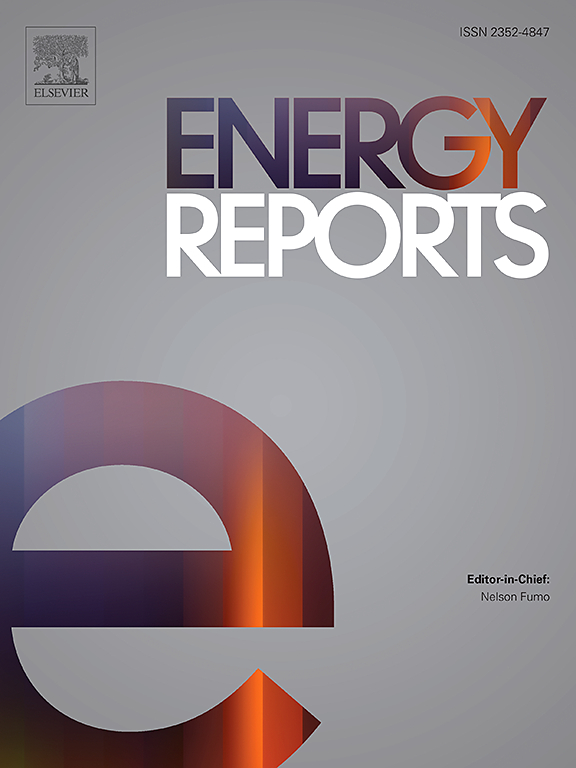解决光伏(PV)预测挑战:使用混合(LSTM-GRU)模型预测实际光伏发电的卫星驱动数据模型
IF 5.1
3区 工程技术
Q2 ENERGY & FUELS
引用次数: 0
摘要
本研究提出了一种利用卫星输入预测数据稀缺地区实际光伏发电的可靠方法,解决了当前预测模型的主要局限性。它的新颖之处在于,通过引入两个数据集之间清晰透明的经验关系,应用改进的z-score转换来弥合卫星衍生和测量光伏发电之间的分布差距。通过使用17年的PVGIS卫星数据和厄立特里亚Areza一年的光伏发电测量数据,在不同的成熟模型(XGBoost、SARIMAX、CNN-LSTM、LSTM-GRU和inforformer)中通过三种不同的场景严格验证了所提出方法的有效性。Informer模型的表现一直优于其他模型,强调了它对复杂预测任务的适用性,而传统模型表现不佳。第一种方案使用卫星数据进行训练和测试,作为基线,在一致的条件下验证模型的性能和可靠性。在情景2和情景3中,分别使用未经修正z-score转换的卫星数据训练的模型来预测实际光伏发电量。转换后的数据(场景3)产生了很好的准确性,与未转换的情况(场景2)相比,在R2中实现了高达43% %的增强。此外,结果表明,第一种和第三种情景的预测误差差异仅为0.69 %,表明差距几乎可以忽略不计。值得注意的是,数据转换提高了所有模型的预测精度,证明了该方法在数据稀缺区域的鲁棒性和有效性。研究结果为研究人员、系统运营商和政策制定者提供了实用的指导,旨在扩大数据稀缺地区的光伏整合。本文章由计算机程序翻译,如有差异,请以英文原文为准。
Addressing photovoltaic (PV) forecasting challenges: Satellite-driven data models for predicting actual PV generation using hybrid (LSTM-GRU) model
This study proposes a robust approach for predicting actual PV generation in data-scarce regions using satellite-derived inputs, addressing key limitations in current forecasting models. Its novelty lies in applying a modified z-score transformation to bridge the distribution gap between satellite-derived and measured PV generation by introducing a clear and transparent empirical relationship between the two data sets. The effectiveness of the proposed approach is rigorously validated across a diverse set of well-established models (XGBoost, SARIMAX, CNN-LSTM, LSTM-GRU, and informer) through three distinct scenarios using 17 years of PVGIS satellite data and one year of measured PV generation data from Areza, Eritrea. The Informer model consistently outperformed others, underscoring its suitability for complex forecasting tasks, while traditional models showed low performance. The first scenario, which uses satellite-derived data for both training and testing, serves as a baseline to verify model performance and reliability under consistent conditions. In scenarios 2 and 3, actual PV generation was forecasted using models trained on satellite-derived data without and with modified z-score transformation, respectively. The transformed data (scenario 3) yielded promising accuracy, achieving an enhancement by up to 43 % in R2 compared to the untransformed case (scenario-2). Furthermore, results showed that the prediction error difference between the first and third scenarios was only 0.69 %, indicating a nearly negligible disparity. Notably, data transformation improves forecasting accuracy across all models, demonstrating the approach’s robustness and effectiveness in data-scarce regions. The findings provide practical guidance for researchers, system operators, and policymakers aiming to scale PV integration in data-scarce regions.
求助全文
通过发布文献求助,成功后即可免费获取论文全文。
去求助
来源期刊

Energy Reports
Energy-General Energy
CiteScore
8.20
自引率
13.50%
发文量
2608
审稿时长
38 days
期刊介绍:
Energy Reports is a new online multidisciplinary open access journal which focuses on publishing new research in the area of Energy with a rapid review and publication time. Energy Reports will be open to direct submissions and also to submissions from other Elsevier Energy journals, whose Editors have determined that Energy Reports would be a better fit.
 求助内容:
求助内容: 应助结果提醒方式:
应助结果提醒方式:


